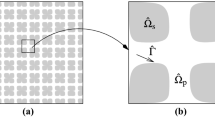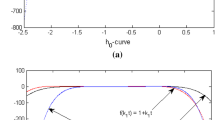Abstract
The Fickian dispersion equation is the basic relationship used to describe the nonconvective mass flux of a solute in a porous medium. This equation prescribes a linear relationship between the dispersive mass flux and the concentration gradient. An important characteristic of the Fickian relationship is that it is independent of the history of dispersion (e.g. the time rate of change of the dispersion flux). Also, the dispersivities are supposed to be medium constants and invariant with temporal and spatial scales of observation. It is believed that in general these restrictions do not hold. A number of authors have proposed various alternative relationships. For example, differential equations have been employed that prescribe a relationship between the dispersion flux and its time and space derivatives. Also, stochastic theories result in integro-differential equations in which dispersion tensor grow asymptotically with time or distance. In this work, three different approaches, which lead to three different non-Fickian equations with a transient character, are discussed and their primary features and differences are highlighted. It is shown that an effective dispersion tensor defined in the framework of the transient non-Fickian theory, grows asymptotically with time and distance; a result which also follows from stochastic theories. Next, principles of continuum mechanics are employed to provide a solid theoretical basis for the non-Fickian transient dispersion theory. The equation of motion of a solute in a porous medium is used to provide a rigorous derivation of various dispersion relationships valid under different conditions. Under various simplifying assumptions, the generalized theory is found to agree with the conventional Fickian theory as well as several other non-Fickian relationships found in the literature. Moreover, it is shown that for nonconservative solutes, the traditional dispersion tensor is affected by the rate of mass exchange of the solute.
Similar content being viewed by others
Abbreviations
- A :
-
measure of auto-correlation strength in Scheidegger's equation, [T]
- A :
-
three-dimensional counterpart of A, [T]
- A supsinf* :
-
relative free energy per unit mass of a solute, [L2T−2]
- C :
-
concentration of a solute, [ML−3]
- D :
-
dispersion tensor, [L2T−1]
- D 0 :
-
modified dispersion tensor in Tompson's theory, [L2T−2]
- D m :
-
effective diffusion coefficient, [L2T−1]
- f :
-
modified dispersion flux vector, [LT−1]
- g :
-
gravity vector, [LT−2]
- I :
-
unit tensor, [-]
- J :
-
solute dispersion flux in one dimension, [ML−2 T−1]
- J :
-
solute dispersion flux vector, [ML−2 T−1]
- q :
-
Darcy velocity, [LT−1]
- \(\widehat{ r }\) :
-
rate of exchange of mass for a nonconservative solute, [T−1]
- R :
-
resistance (to dispersion) tensor, [M−1 L3T−1]
- s:
-
source term due to diffusion in equation of motion of a solute, [L−1T−1]
- t :
-
time, [T]
- \(\widehat{ T }\) :
-
resistance force (per unit mass) exerted on a component by all other components of the porous medium, [LT−2]
- u s :
-
relative velocity of the solute, [LT−1]
- v :
-
fluid velocity vector, [LT−1]
- v :
-
magnitude of fluid velocity vector, [LT−1]
- α L :
-
longitudinal dispersivity, [L]
- α T :
-
transversal dispersivity, [L]
- β :
-
a new dispersivity coefficient in Scheidegger's equation, [L}]
- α 1 :
-
and β 2 modified dispersivities in Tompson's theory, [-]
- η :
-
a tensor property in Tompson's theory, [L−2]
- μ supsinf* :
-
relative chemical potential of a solute, [L2T−2]
- ϱ :
-
mass density of fluid, [ML−3]
- σ :
-
stress tensor, [ML−1T−2]
- τ supsinf* :
-
nonequilibrium part of the solute resistance force \(\widehat{ T }\) 3, [LT−2]
- ω :
-
solute mass fraction, [-]
- T :
-
transpose of a vector or a tensor
- w :
-
pure water component of the fluid phase
- s :
-
solute components of the fluid phase
References
Dagan, G.: 1989, Flow and Transport in Porous Media, Springer-Verlag, Berlin.
De Josselin de Jong, G.: 1958, Longitudinal and transverse diffusion in granular deposits, Trans. Amer. Geophys. Union, 39, 67–74.
Glass, D. E. Özisik, M. N., and McRae, D. S.: 1987, Hyperbolic heat conduction with radiation in an absorbing and emitting medium, Numer. Heat Transfer 12, 321–333.
Hassanizadeh, S. M.: 1986a, Derivation of basic equations of mass transport in porous media, Part 1. Macroscopic balance laws, Adv. Water Resour. 9, 196–206.
Hassanizadeh, S. M.: 1986b, Derivation of basic equations of mass transport in porous media, Part 2. Generalized Darcy's and Pick's laws, Adv. Water Resour. 9, 207–222.
Hassanizadeh, S. M. and Leijnse, A.: 1995, A Non-linear theory of high-concentration-gradient dispersion in porous media, Adv. Water Resour. 18, 203–215.
Maas, C.: 1994, On convolutional processes and dispersive groundwater flow, PhD Thesis, Faculty of Civil Engineering, Delft University of Technology, Delft, The Netherlands, 1994.
Matheron, G. and De Marsily, G.: 1980, Is transport in porous media always diffusive? A counter example, Water Resour. Res. 16, 901–917.
Raats, P. A. C.: 1981, Transport in structured porous media, in A. Verruijt and F. Borends (eds), Proceedings of Euromech 143, pp. 221–226.
Scheidegger, A. E.: 1958, Typical solutions of the differential equations of statistical theories of flow through porous media, Trans. Amer. Geophys. Union 39, 929–932.
Scheidegger, A. E.: 1960, The Physics of Flow Through Porous Media, Univ. of Toronto Press, Toronto.
Strack, O. D. L.: 1992, A mathematical model for dispersion with a moving front in groundwater, Water Resour. Res. 28, 2973–2980.
Tompson, A. F. B.: 1988, On a new functional form for the dispersive flux in porous media, Water Resour. Res. 24, 1939–1947.
Tompson, A. F. B. and Gray, W. G.: 1986, A second-order approach for the modeling of dispersive transport in porous media, 1. Theoretical development, Water Resour. Res. 22, 591–599.
Author information
Authors and Affiliations
Additional information
Also with National Institute of Public Health and Environmental Protection (RIVM), PO Box 1; 3720BA Bilthoven, The Netherlands
Rights and permissions
About this article
Cite this article
Hassanizadeh, S.M. On the transient non-Fickian dispersion theory. Transp Porous Med 23, 107–124 (1996). https://doi.org/10.1007/BF00145268
Received:
Revised:
Issue Date:
DOI: https://doi.org/10.1007/BF00145268




